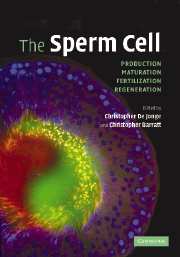Book contents
- Frontmatter
- Contents
- Preface
- List of contributors
- 1 Mammalian spermatogenesis and sperm structure: anatomical and compartmental analysis
- 2 Sperm chromatin stability and susceptibility to damage in relation to its structure
- 3 Genomic and proteomic approaches to defining sperm production and function
- 4 Sperm maturation in the human epididymis
- 5 Controls of sperm motility
- 6 Regulation of capacitation
- 7 Reactive oxygen species: friend or foe
- 8 Testing sperm manufacturing quality: the sperm–zona binding assay
- 9 Genetics: a basic science perspective
- 10 Sex chromosome abnormalities and male infertility: a clinical perspective
- 11 Epigenetic patterning in male germ cells: importance of DNA methylation to progeny outcome
- 12 The DAZ gene family and human germ cell development from embryonic stem cells
- Index
8 - Testing sperm manufacturing quality: the sperm–zona binding assay
Published online by Cambridge University Press: 14 August 2009
- Frontmatter
- Contents
- Preface
- List of contributors
- 1 Mammalian spermatogenesis and sperm structure: anatomical and compartmental analysis
- 2 Sperm chromatin stability and susceptibility to damage in relation to its structure
- 3 Genomic and proteomic approaches to defining sperm production and function
- 4 Sperm maturation in the human epididymis
- 5 Controls of sperm motility
- 6 Regulation of capacitation
- 7 Reactive oxygen species: friend or foe
- 8 Testing sperm manufacturing quality: the sperm–zona binding assay
- 9 Genetics: a basic science perspective
- 10 Sex chromosome abnormalities and male infertility: a clinical perspective
- 11 Epigenetic patterning in male germ cells: importance of DNA methylation to progeny outcome
- 12 The DAZ gene family and human germ cell development from embryonic stem cells
- Index
Summary
Introduction
Infertility in general and the proportion of cases where a male factor can be identified as the cause (alone or in combination with female factors) are prevalent conditions (Centers for Disease Control and Prevention, 1997; Hull et al., 1985; Mosher and Pratt, 1990). Although diagnostic problems make it difficult to establish the extent of the male partner's contribution with certainty, a number of studies suggest that male problems represent the commonest single defined cause of infertility (Irvine, 1998).
Current treatment options for male infertility include a variety of urological procedures (surgical and non-surgical), medical–pharmacological interventions, low complexity assisted reproductive procedures (such as intrauterine insemination (IUI) therapy), and the more advanced and complex assisted reproductive technologies (ARTs). Among the latter, in vitro fertilization (IVF) and embryo transfer, augmented with intracytoplasmic sperm injection (ICSI) in the moderate and severe male factor cases, constitute validated and successful ways to assist fertilization. The national statistics from the USA (Centers for Disease Control and Prevention, 2004) reported a 44% incidence of ICSI in 115,392 ART cycles performed during 2002, a figure that highlights the impact that this assisted fertilization technique has recently had on infertility management.
Other lines of investigation have recently provided further reasons for concern in the area of human male reproduction. First, some researchers have reported an overall decline in the quantity and quality of spermatozoa present in semen, perhaps caused by reproductive bio-hazards, for example, environmental estrogens (Irvine, 1997).
- Type
- Chapter
- Information
- The Sperm CellProduction, Maturation, Fertilization, Regeneration, pp. 194 - 216Publisher: Cambridge University PressPrint publication year: 2006
- 2
- Cited by



